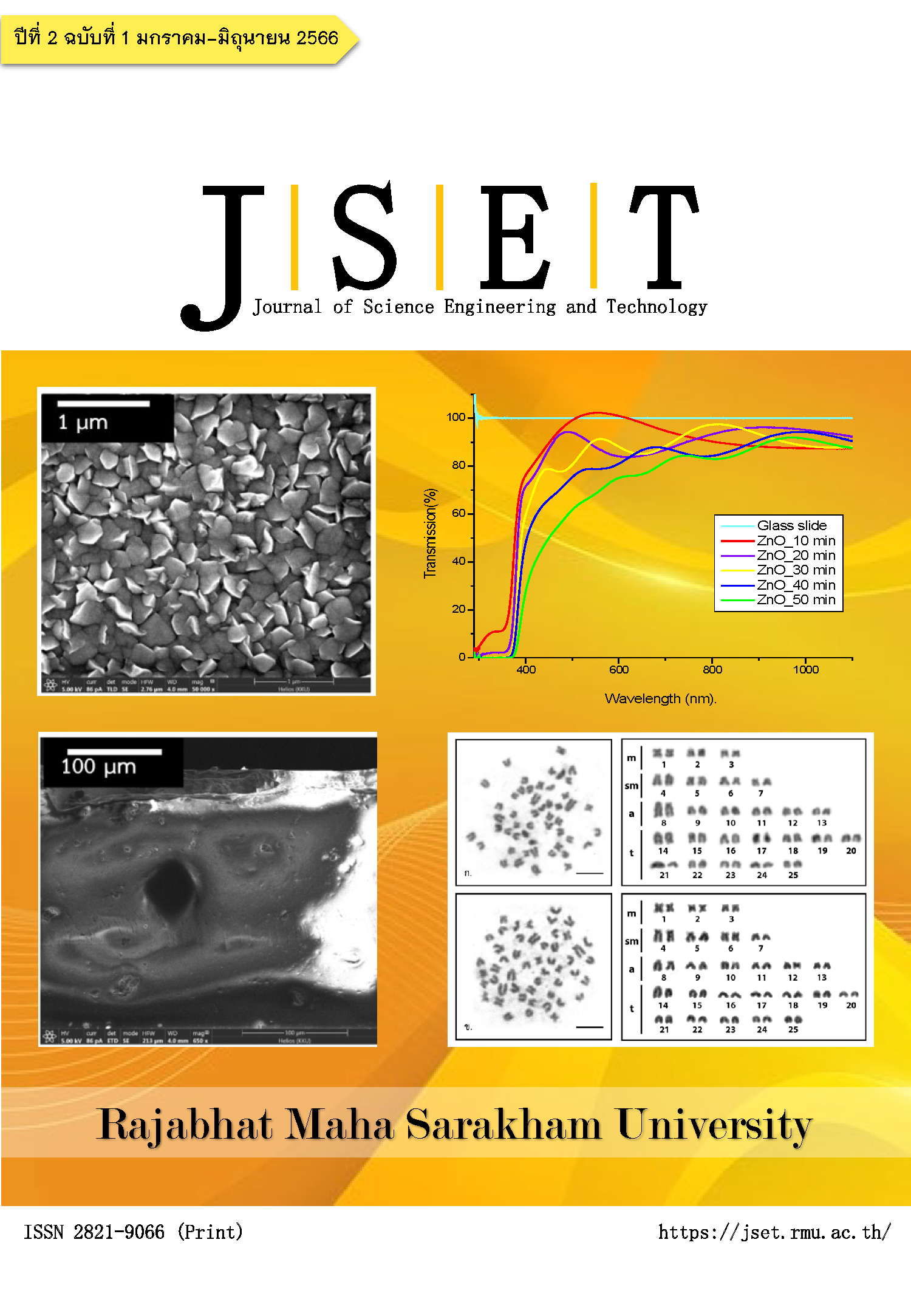Chemical Properties, Total Phenolic Content, Total Anthocyanin, and Antioxidant Activity of Muntingia calabura Fermented Vinegar Macerate with Cannabis sativa and Mitragyna speciosa
Main Article Content
บทคัดย่อ
Muntingia calabura is a fruit found mainly in northeast of Thailand. The fruit is sweet and red when ripe. Processing into vinegar will encourage more utilization of the fruit. This objective of the study is vinegar production from Muntingia calabura wines, chemical properties total phenolic content, total anthocyanin, and antioxidant activity of fermented vinegar from Muntingia calabura that is macerated with 2 types of herbs: Cannabis sativa and Mitragyna speciosa. The first step made Muntingia calabura wine by using Saccharomyces cerevisiae (0.75% v/v of Muntingia calabura juice content) to produce alcohol. The second step made vinegar by inoculating Acetobacter pasteurianus 10 %(v/v) into Muntingia calabura wines which were adjusted alcohol content to 5.38 %(v/v), fermented at room temperature for 15 days. The results show that on the 5th day of alcoholic fermentation, the alcohol content was 6.45 %(v/v) and vinegar had acetic acid at 4.00 %(v/v). After that bring the herb (Cannabis sativa and Mitragyna speciosa) macerated in Muntingia calabura vinegar for 3 days. The highest antioxidant activity of Muntingia calabura vinegar macerated with Cannabis sativa was found to be 24.75 mg/mL. The highest total phenolic content and total anthocyanin of Muntingia calabura vinegar macerated with Mitragyna speciosa were 4.32 g/L and 50.94 mg/L, respectively. From this research, Muntingia calabura could be processed to make new, healthy products and further lead to income generation for people.
Article Details

อนุญาตภายใต้เงื่อนไข Creative Commons Attribution-NonCommercial-NoDerivatives 4.0 International License.
เอกสารอ้างอิง
Aguiar, A., Nascimenta, R. A. D. A., Ferretti, L. P., & Goncalves, A. R. (2005). Determination of organic acids and ethanol in commercial vinegars. Brazilian Journal of Food Technology 5o SIPAL, Macro, 51-56
Ahmed, M., Ji, M., Qin, P., Gu, Z., Liu, Y., SikandarI, A., Iqbal, M. F., & Javeed, A. (2018). Phytochemical screening, total phenolic and flavonoids contents and antioxidant activities of Citrullus colocynthis L. and Cannabis sativa L. Applied ecology and environmental research, 17(3), 6961-6979
Ananda, A. P., Nagendra, B. S., Krishnakantha, T. P. & Joseph, R. (2012). Enhancement of antioxidant profile of Japanese cherry (Muntingia calabura Linn.) by alcoholic fermentation. Int. J. of Pharm. & Life Sci. (IJPLS), 3(6), 1743-1751
Bakir, S., Devecioglu, D., Kayacan, S., Toydemir, G., Karbancioglu‑Guler, F. & Capanoglu, E. (2017). Investigating the antioxidant and antimicrobial activities of different vinegars. Eur Food Res Technol. https://doi 10.1007/s00217-017-2908-0
Boonsupa, W., Onputta, K., Ajduangdee, W., Glaichid, P., Pupaijitkul, A. & Richomrat, T. (2021). Comparative chemical properties and antioxidant activity of two types of pomegranates fermented vinegar. Asia-Pacific Journal of Science and Technology, 26(2), 1-6
Boonsupa, W. & Kerdchan, K. (2021). Development of Fermented Prunus Vinegar: Chemical Characterization and Antioxidant Activity. Current Applied Science and Technology, 21(1), 75-84
Boonsupa, W. (2019). Chemical properties, antioxidant activities and sensory evaluation of berry vinegar. Walailak J Sci Tech, 16(11), 887-896
Brand-Williams, W., Cuvelier, M. E. & Berset, C. (1995). Use of a free radical method to evaluate antioxidant activity. LWT – Food Science and Technology, 28, 25-30
Cejudo-Bastante M. J., Durán, E., Castro, R., Rodríguez-Dodero, M. C., Natera, R. & García-Barroso, C. (2013). Study of the volatile composition and sensory characteristics of new Sherry vinegar-derived products by maceration with fruits. LWT–Food Science and Technology, 50, 469-479
Cantele, C., Bertolino, M., Bakro, F., Giordano, M., Jedryczka, M.and Cardenia, V. (2020).
Antioxidant Effects of Hemp (Cannabis sativa L.) Inflorescence Extract in Stripped Linseed Oil. Antioxidants, 9, 1131. https://doi:10.3390/antiox9111131
Chen, Y., Huang, Y., Bai, Y., Fu, C., Zhou, M., Gao, B., Wang, C., Li, D., Hu, Y., & Xu, N.
(2017). Effects of mixed cultures of Saccharomyces cerevisiae and Lactobacillus plantarum in alcoholic fermentation on the physicochemical and sensory properties of citrus vinegar. LWT – Food Science and Technology, 84, 753-763
Drint’c, Z., Vidovi’c, S., Vladi’c, J., Koren, A., Kiprovski, B., & Sikora, V. (2018). Effect of extraction solvent on total polyphenols content and antioxidant activity of industrial hemp (Cannabis sativa L.). Lekovite Sirovine, 38, 17-21
Goh, Y. S., Karunakaran, T., Murugaiyah, V., Santhanam, R., Bakar, M. H. A. & Ramanathan, S. (2021). Accelerated Solvent Extractions (ASE) of Mitragyna speciosa Korth. (Kratom) Leaves: Evaluation of Its Cytotoxicity and Antinociceptive Activity.Molecules, 26, 3704
Gustafsson, F. S., Jiranek, V., Neuner, M., Scholl, C. M., Morgan, S. C., & Durall, D. M. (2016). The Interaction of Two Saccharomyces cerevisiae Strains Affects Fermentation-Derived Compounds in Wine. Fermentation 2, 9. https://doi:10.3390/fermentation2020009
León, F., Habib, E., Adkins, J. E., Furr, E. B., McCurdy, C. R. & Cutler, S. J. (2009). Phytochemical characterization of the leaves of Mitragyna speciosa grown in USA. Natural product communication, 4(0), 1-4
Luzón-Quintana, L. M., Castro, R. & Durán-Guerrero, E. (2021). Biotechnological Processes in Fruit Vinegar Production. Foods, 10, 945. https://doi.org/10.3390 /foods10050945
Minh, N. P., Nhan, N. P. T., Thuong, L. B., Thanh, B. H., Tho, N. T. & Thien, L. X. (2019). Utilization of Straw Berry (Muntingia Calabura) Fruit for Wine Fermentation. J.Pharm. Sci. & Res, 11(4), 1427-1430
Mnekin, L., & Ripoll, L. (2021). Topical Use of Cannabis sativa L. Biochemicals. Cosmetics, 8(85). https://doi.org/10.3390/cosmetics8030085
Ozdemir, N., Pashazadeh, H., Zannou, O., & Koca, I. (2022). Phytochemical content, and antioxidant activity, and volatile compounds associated with the aromatic property, of the vinegar produced from rosehip fruit (Rosa canina L.). LWT – Food Science and Technology, 154, 112716.
Ozturk, I., Caliskan, O., Tornuk, F., Ozcan, N., Yalcin, H., Baslar, M., & Sagdic, O. (2015).
Antioxidant, antimicrobial, mineral, volatile, physicochemical and microbiological characteristics of traditional home-made Turkish vinegars. LWT - Food Sci Tech, 63, 144-51
Phaya, M. (2013). Extraction and Antioxidant Assays of Anthocyanins for Natural Food Colorant Development from Some Plants [Master’s thesis]. Faculty of Science, Chiang Mai University.
Pereira, G. A., Arruda, H. S., Morais, D. R., Eberlin, M. N., & Pastore, G. M. (2018). Carbohydrates, volatile and phenolic compounds composition, and antioxidant activity of calabura (Muntingia calabura L.) fruit. Food Research International, 108, 264-273
Singleton, V. L., Orthofer, R., & Lamuela-Raventós, R. M. (1999). Analysis of total phenols and other oxidation substrates and antioxidants by means of Folin- Ciocalteu reagent. Methods Enzymol, 299, 152-178.
Shu, Y., Sun, S. Y., Jiang, W. G., & Zhao, Y. P. (2011). Evaluation of different Saccharomyces cerevisiae strains on the profile of volatile compounds and polyphenols in cherry wines. Food Chemistry, 127, 547–555
Ubeda, C., Callejón, R. M., Hidalgo, C., Torija, M. J., Troncoso, A. M., & Morales, M. L. (2012). Employment of different processes for the production of strawberry vinegars: Effects on antioxidant activity, total phenols and monomeric anthocyanins. LWT Food Sci. Tech, 52, 139-45
Vijayanand, S., & Thomas, A. S. (2018). Screening of Muntingia calabura and Theobroma
cacao for potential bioactives. International Journal of Recent Scientific Research, 9(1), 22991-22996


